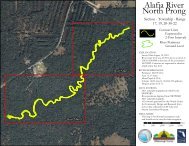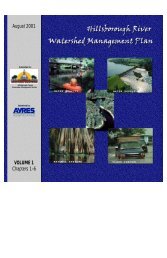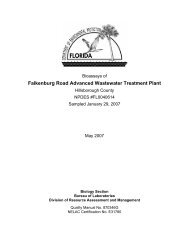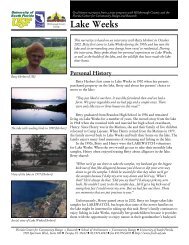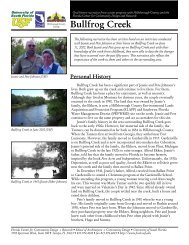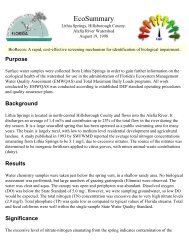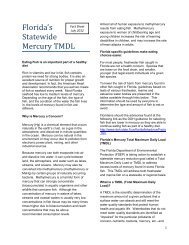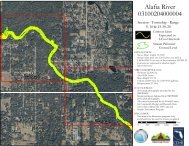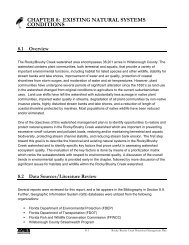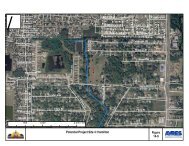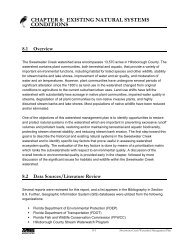Adopt-A-Pond Newsletter - Spring 2013 - Hillsborough County ...
Adopt-A-Pond Newsletter - Spring 2013 - Hillsborough County ...
Adopt-A-Pond Newsletter - Spring 2013 - Hillsborough County ...
Create successful ePaper yourself
Turn your PDF publications into a flip-book with our unique Google optimized e-Paper software.
On Our <strong>Pond</strong>A NEWSLETTER FOR CLEANER WATER & BETTERAQUATIC ENVIRONMENTS IN HILLSBOROUGH COUNTYVolume 19, No 1<strong>Spring</strong> <strong>2013</strong>Taliaferro <strong>Pond</strong>s Projectsee page 3 for detailsINSIDE THIS ISSUENew Program Videos on YouTubeBeautify Your <strong>Pond</strong> With <strong>Adopt</strong>-A-<strong>Pond</strong>!Pledge to Prevent Pet Waste PollutionChanging Your Perception of Your LakeOn Our <strong>Pond</strong>Quarterly <strong>Newsletter</strong> Published By:<strong>Hillsborough</strong> <strong>County</strong> Public WorksEnvironmental Services2420 N. Falkenburg RoadTampa, FL 33619(813) 744-5671www.hillsboroughcounty.org/publicworks<strong>Adopt</strong>-A-<strong>Pond</strong>: Jennifer Aragonaragonj@hillsboroughcounty.orgLakes & Streams: John McGeemcgeej@hillsboroughcounty.orgwww.hillsborough.wateratlas.org
page 2On Our <strong>Pond</strong>AlligatorsFlorida swamps are known for their alligators. They’ve even been named our state reptile! Once close toextinction, they now thrive in the southern United States. Alligators can live around 50 years in the wild and it’sestimated the species has been around for 150 million years.Alligators are important reptiles that other animals depend on. For instance, they make holes in the ground wherewater fills during dry times of the year. Fish and other animals rely on these water filled holes for survival.They’re also part of Florida’s tourism industry, especially around the Everglades. But, those of us who live on alake or pond might not have to travel very far to see one. That’s because development has pushed people andalligator habitat closer together. Alligators aren’t man-eating machines, though. Their diet includes animals such asfish, turtles, snakes, small mammals, and birds. They can mainly be found eating around dusk and overnight. It’svery rare that someone is injured or killed by an alligator, but here are some tips to stay safe.Never feed an alligator, even if it’s something theywould normally eat in the wild. Alligators have anatural fear of people and feeding them causes themto look to people for food. What may seem innocentat first, might end up in Fido’s demise later on. It’salso illegal to feed them, for this very reason.Also, never approach an alligator, especially whenthey’re nesting (during the summer). The females areprotective of their nests and their young. Enjoy theirpresence from a distance.photo by Bob LuceWith these simple tips, you can enjoy coexisting withthese prehistoric creatures.New Program Videos on YouTubeWe recently posted more videos highlightingvarious components of our environmentalprograms. Our latest endeavours include a pondwork day to identify and remove nuisance plants,a pond planting, and a couple “how-to” videos forremoving duckweed and building a trash catcher.Our newest video on duckweedremoval is now posted on YouTube!These videos can be viewed at any time. Whetheryou want to enhance the look of your pond orlearn how to make a device for capturing trash,you can refer to these videos for guidance.Check out all our videos atwww.hillsborough.wateratlas.usf.edu/AAP/. Weperiodically add new videos, so make sure tocheck back often. Let us know what you think!
On Our <strong>Pond</strong> page 3Taliaferro <strong>Pond</strong>s ProjectTucked away behind a small neighborhood in Tampa, there’s a property with a series of stormwater ponds ownedby <strong>Hillsborough</strong> <strong>County</strong>. We’ve used these ponds periodically over the years to test various pond managementtechniques.Most recently, we tested our <strong>Adopt</strong>-A-<strong>Pond</strong> maintenance recommendations to make sure they’re realistic toundertake and keep ponds in order. We started by getting four of our staff members together to hand pull theinvasive plants from one of the ponds. It only took us about half-an-hour and we uncovered several native plants inthe process. We also took the opportunity to film the workday and posted it on YouTube. You can view the videofrom the <strong>Adopt</strong>-A-<strong>Pond</strong> website at www.hillsborough.wateratlas.org/AAP. Our recommendations were found tobe accurate. We were able to keep the invasive vegetation controlled and spot any potential problems during ourinspections.Following the clean-up, we tested our <strong>Adopt</strong>-A-<strong>Pond</strong> planting strategy. We ran into a snag when we discovered thatexotic apple snails had eaten most of our first planting. We had to re-plant the pond using plants that are lessprefered by apple snails. We also removed them and their eggs whenever we saw them. In the end, one applicationof molluscicide resolved the problem. This allowed the plants to fill in and help keep the invasive plants at bay.Our planting video can also be found on YouTube.We’re currently testing how well a heavily planted pond can remove pollutants from the water. We started bycollecting water samples for over a year to give us a good picture of what the water was like prior to working on it.We then heavily planted the pond. It took two separate plantings to get full coverage. The water level drasticallyfluctuates, so we planted a large range of the shoreline too (both high and low). A lot of submerged plants wereadded because they are the workhorse for filtering the water. We’ll continue to sample the pond for at least anotheryear to find out if we see any changes as a result of the planting.We’ve always known <strong>Adopt</strong>-A-<strong>Pond</strong> works, but now we have empirical evidence. We’re also excited to see howeffective our methods are at removing pollutants. Look for project updates in the next year.Blue-flag irises are one of severalplants used to filter the pond water.
page 4<strong>Pond</strong>er This - The Penguin EffectOn Our <strong>Pond</strong>Let’s get inand plant.But, scary creatureslive in there!We haveto get inthere?!She wasn’teaten...Hmm...Thatdoesn’tlook sobad...1 2We shouldplant moreover here.This iseasier thanI thought!And it’s alot of fun!3<strong>Pond</strong> Plant Spotlight: Royal FernBy: Alexis ThomasOsmunda regalis, also known as the Royal fern, is of Saxonorigin. It is commonly referred to as “Royal” because thescientific name, Osmunda, is one of the titles of Thor - a pagandeity and one of the Marvel Avengers. This fern is found inswampy areas with lots of moisture. The Royal fern is one ofthe most widespread species on the planet, being found on everycontinent except Australia and Antarctica.This beautiful plant produces many fronds that can span out to 3feet. It has no blossoming flowers. A separate branch is formedthat contains the sporangia. Sporangia are how ferns reproduce.The ferns are said to be able to survive over 100 years. Maybethat’s how they’ve been around since the dinosaurs!Royal fern is named afterThor, the Saxon god of war.Royal ferns are not only great to have for their brilliant greenery,but also because they are completely low maintenance. They don’t need tobe pruned or watered. This fern prefers shady areas, but will tolerate full sun if it has plenty of water.Choose this great plant for around your pond or for any moist areas in your yard!
On Our <strong>Pond</strong> page 5Beautify Your <strong>Pond</strong> With <strong>Adopt</strong>-A-<strong>Pond</strong>!We are now accepting applications forour <strong>Adopt</strong>-A-<strong>Pond</strong> program! Whetheryou’re new to our program or it’s beenawhile since you joined and you needmore help, you should apply. Ourprogram partners with communities toimprove the water quality, wildlife habitatand appearance of stormwater ponds.We guide you through the initial steps tohelp you learn how to properly care foryour pond over the long-term. But theproject success ultimately depends on you!There are no fees or costs required toparticipate. Simply apply to see if yourpond qualifies.To get started, you’ll need:Plants enhance the shoreline of this pond in Riverview.Enthusiastic Group. Willing to get in thewater to clean-up, plant, maintain, and monitor the pond. <strong>Adopt</strong>ing a pond is too much of a job for one person. Getyour neighbors together and have fun with it!Group Representative. Someone who will organize the project and communicate with the group and the <strong>Adopt</strong>-A-<strong>Pond</strong> coordinator.Time. A pond can’t be transformed overnight. It takes months and years to see the full effects of the change. That’swhy the <strong>Adopt</strong>-A-<strong>Pond</strong> process is a three-year agreement.Apply. The application can be found at www.hillsborough.wateratlas.org/AAPWe Want to Know!This newsletter is for you, the reader. We’re always looking to improve it and your input is crucial.We want to know:What topic(s) would you like to read about?____________________________________________________________________________________________Which of our previous series or articles have you liked and/or disliked?____________________________________________________________________________________________We’re also working on updating our contacts database and we want to keep you informed. If you’ve changed youremail and/or mailing address, tell us so we can update our records. We use our contact list to send program relatedmaterials and updates, including exclusive opportunities and freebies.Name:______________________________________Updated email address:______________________________________Updated address:______________________________________Send your completed response by email to aragonj@hillsboroughcounty.org or cut-out and mail this form to<strong>Adopt</strong>-A-<strong>Pond</strong>, 2420 N. Falkenburg Rd., Tampa 33619.
page 6On Our <strong>Pond</strong>Pledge to Prevent Pet Waste PollutionOne of the worst feelings is to be walking along, when suddenly you realize you just stepped in a steaming pile of dogdoo doo! It’s not only disgusting to step in it, but pet waste is a source of water pollution that’s easily preventable.When pet waste is left on the ground, rain and irrigation water washes it into storm drains that flow to ponds, lakes,rivers, and eventually Tampa Bay. There’s harmful bacteria and nutrients in it that can make people sick, cause beachclosings, and lead to algae blooms.Be a responsible pet owner and pick-up after your pet every time. Put pet waste in the trash andnever in the storm drain; storm drains all lead to a waterbody. Pledge to do your part to preventpet waste pollution by visiting http://petwaste.shorturl.com. As our “thank you,” we’ll send youa pet waste bag dispenser (while supplies last).Free Bag DispenserCreate Your Own Plant ScrapbookBy: Alexis ThomasDo you ever find a plant in your yard that youjust can’t identify? Start a digital scrapbookand never forget it again!Here’s how to do it. Take a picture of theflower or plant you find and want to identify,then search the internet to find its scientificname. A great website to start with iswww.floridasnature.com. Through this site,you can search by flower color using picturesof many of Florida’s common plants andwildflowers. If you get stuck, you can alwaysask us.After identifying the plant, you can useMicrosoft Word, Powerpoint, or a similarprogram and insert pictures of the plant alongwith its common and scientific name. Add any other useful information to the page that you may want toremember in the future.By keeping a log of the flowers and plants in your yard, you can better understand what can grow on your land andhow to keep it beautiful.
On Our <strong>Pond</strong> page 7Changing Your Perception of Your LakeMost people haven’t thought about it, but it’s true:What you believe about something influences what youexpect is possible. For example, answer this question:How clear should water be?Each of us will answer thisdifferently. Did you say,perfectly clear? Chances areyou’re thinking I meantdrinking water, or you’re froma northern location with glaciallakes, or perhaps theCaribbean with sandy azurewater and mountain streams.Or maybe you grew up aroundthe springs like me. Am Iright?Perhaps you said, a few feet of clearwater. If so, you’re likely fromthe southern or midwestUnited States with muddyrivers and clay-colored lakes.Or maybe you grew up righthere in blackwater<strong>Hillsborough</strong> <strong>County</strong>.Or perhaps you said, itdepends. In this case, you’velikely seen various waters. Oryou’ve studied lakes andrealize that there are manyfactors influencing waterclarity.Of course this is an imperfect example, but it makes thepoint that what we expect is based on our ownexperience. This means we might actually be expectingsomething that is not realistic. We might be satisfiedwith a condition that is not as good as it could be oronce was. Or we may be expecting our waterbody tobe something it never can be. Obviously, this has animpact on what we try to do in our lakes and ponds. Italso might explain why some people have so muchtrouble getting others in their community to participatein their management efforts.The clear, white sands beach ofLake Michigan (upper photo)compared to the vegetatedshoreline and dark water of LakeThonotosassa (lower photo).photo by David Eilers, FCCDRdifficulties we face with lakes and ponds. Some peopleexpect to do work, others don’t. Some expect scarythings in the water, others see them as peaceful andenjoyable places. Still otherssee them as playgrounds forsports.Since we’re often unaware ofour paradigms, we can talkabout the same waterbody andmean totally different things.Words like “good,” “bad,”“improve,” and “restore” areopinion terms. They meanvarious things to other people.Using them to describe yoursituation can result inconfusion when your imageand theirs don’t match up. A “goodimprovement” to a fishermanfrom South Florida may meansomething different to aretired banker from NewJersey, or a college studentfrom Puerto Rico.Here’s two simple steps tohelp get around paradigmproblems:1. Use definite words.Instead of “improving,”say “vegetation control” orwhatever else specificallydescribes what you want.It won’t stop all misunderstandings but it willreduce many of them.2. Know the facts. We have very good records onmost water resources in the area going back manyyears. Check the historic conditions and look atlong term data. Most of this information can befound at www.hillsborough.wateratlas.org. Withfew exceptions, any information available about awaterbody is packaged up for you right on thiswebsite.These kinds of problems are called paradigm issues.The more you look into it, the more you’ll find thatparadigm issues are at the root of many of theAs always, if you don’t understand something, just ask.We’re here to help.
The <strong>Adopt</strong>-A-<strong>Pond</strong> Program<strong>Hillsborough</strong> <strong>County</strong> Public Works Dept.Environmental Services2420 N Falkenburg Rd.Tampa, FL 33619Mail Code 1384Pre sort StandardU.S. Postage PaidTampa, FL 33601Permit No 295<strong>Hillsborough</strong> <strong>County</strong> Board of <strong>County</strong> CommissionersAn Affirmative Action-Equal Opportunity EmployerKenny Sighting!In the Winter <strong>2013</strong> newsletter, the erosion critter, Kenny,was sighted alongside the septic tank inspector in the“Clean Your Septic Tank” article. He was there showingthat even a small pile of loose dirt can easily wash awayin the rain and cause water pollution.We had several people call or e-mail us with guesses, butonly one person got it right. Kenny was pretty tough tofind this time, but keep an eye out for him because he’slikely to show up again.Erosion can happen anywhere that water flowsdownhill. If you see Kenny anywhere in<strong>Hillsborough</strong> <strong>County</strong> or the troubles he can cause,snap a picture of it with your cell phone and sendit along with your location toreportpollution@hillsboroughcounty.org.On Our <strong>Pond</strong> page 8



